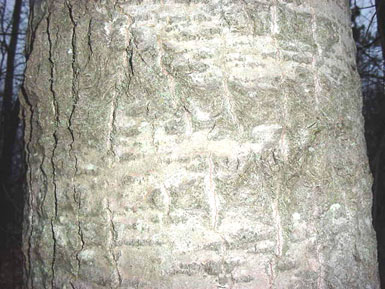Form: This tree is medium sized reaching 60 to 70 ft. in height and 1 1/2 to 2 ft. in dbh. It also has a straight bole and a thin, irregular crown.
Leaves:
Arrangement: alternate
Shape: broadly ovate; short pointed tip
Margin: coarsely serrate
Texture: tomentose
Venation: n/a
Bark: The bark is thin, smooth and greenish in color. It later becomes dark brown with an orange tint and furrowed with flat ridges.

Twigs and buds: The twigs are dull, stout, and grayish-brown in color. The buds are pubescent with a gray to reddish-brown color.
Flowers and fruit: The flowers are dioecious and appear in catkins. The fruit is long and conical.
Distinguishing characteristics: The tree has a straight bole, distinctive leaves, and grayish-brown twigs with pubescent buds.
Range: This species occurs in the Great Lakes area.
Silvics: This species occurs on sandy upland soils and on more nutrient rich sites compared to trembling aspen. It is often found among northern red oak, white oak, and white pine.
Ecological and cultural importance: The wood is used primarily for pulp and particle board. Wildlife love foliage, twigs and buds. Young stands are perfect for ruffed grouse and woodcock habitat.